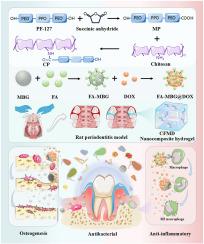热敏抗菌纳米复合水凝胶诱导巨噬细胞极化和骨再生治疗牙周炎
IF 18
1区 医学
Q1 ENGINEERING, BIOMEDICAL
引用次数: 0
摘要
牙周炎是一种由细菌感染引起的慢性炎症性疾病,会导致牙周组织的破坏。传统的治疗包括刮除和刨根结合抗生素,但全身性抗生素治疗往往导致治疗部位药物浓度不足和不良副作用。在这里,我们开发了一种用于局部药物递送的纳米复合热敏水凝胶(CFMD)。壳聚糖接枝的Pluronic®F127水凝胶(CP)具有天然的抗菌活性。热敏材料流入牙周袋后,在体温下转化为凝胶相,填充牙周袋,保存纳米药物。当保留在牙周袋中的水凝胶被降解时,叶酸修饰的MBG纳米颗粒装载强力西环素(FA-MBG@Dox)纳米颗粒将盐酸强力西环素(Dox)递送到牙龈线以下,这是仪器和水凝胶药物载体无法到达的地方,从而实现更深层次的抗菌、抗炎和促进成骨作用。在体外,CFMD水凝胶表现出强大的抗菌活性,促进人牙周韧带干细胞(hPDLSCs)分化,诱导巨噬细胞向抗炎(M2)表型极化。在体内,它能有效抑制牙槽骨丢失,促进骨再生,重塑炎症微环境。本研究表明,具有定向极化调节、氧化应激调节和成骨再生能力的CFMD水凝胶可能为治疗牙周炎提供一种更简单、更有效的方法。本文章由计算机程序翻译,如有差异,请以英文原文为准。

Thermosensitive antibacterial nanocomposite hydrogel guiding macrophage polarization and bone regeneration for periodontitis treatment
Periodontitis is a chronic inflammatory disease caused by bacterial infection that leads to the destruction of periodontal tissues. Traditional treatment involves scaling and root planing combined with antibiotics, but systemic antibiotic therapy often results in insufficient drug concentration at the treatment site and unwanted side effects. Here, we developed a nanocomposite thermosensitive hydrogel (CFMD) designed for localized drug delivery. The chitosan-grafted Pluronic® F127 hydrogel (CP) had natural antibacterial activity. After the thermosensitive material flows into the periodontal pocket, it transforms into a gel phase at body temperature, filling the periodontal pocket and preserving the nanomedicine. As the hydrogel retained in the periodontal pocket is degraded, folic acid-modified MBG nanoparticles loaded with doxycycline (FA-MBG@Dox) nanoparticles deliver doxycycline hydrochloride (Dox) to below the gum line, where instruments and hydrogel drug carriers cannot reach, enabling deeper antibacterial, anti-inflammatory, and osteogenesis-promoting effects. In vitro, CFMD hydrogel exhibited potent antibacterial activity, promoted human periodontal ligament stem cells (hPDLSCs) differentiation, and induced macrophage polarization toward the anti-inflammatory (M2) phenotype. In vivo, it effectively inhibited alveolar bone loss, promoted bone regeneration, and reshaped the inflammatory microenvironment. This study showed that CFMD hydrogel with targeted polarization regulation, oxidative stress regulation and osteogenesis regeneration capabilities may provide a simpler and more effective way for the treatment of periodontitis.
求助全文
通过发布文献求助,成功后即可免费获取论文全文。
去求助
来源期刊

Bioactive Materials
Biochemistry, Genetics and Molecular Biology-Biotechnology
CiteScore
28.00
自引率
6.30%
发文量
436
审稿时长
20 days
期刊介绍:
Bioactive Materials is a peer-reviewed research publication that focuses on advancements in bioactive materials. The journal accepts research papers, reviews, and rapid communications in the field of next-generation biomaterials that interact with cells, tissues, and organs in various living organisms.
The primary goal of Bioactive Materials is to promote the science and engineering of biomaterials that exhibit adaptiveness to the biological environment. These materials are specifically designed to stimulate or direct appropriate cell and tissue responses or regulate interactions with microorganisms.
The journal covers a wide range of bioactive materials, including those that are engineered or designed in terms of their physical form (e.g. particulate, fiber), topology (e.g. porosity, surface roughness), or dimensions (ranging from macro to nano-scales). Contributions are sought from the following categories of bioactive materials:
Bioactive metals and alloys
Bioactive inorganics: ceramics, glasses, and carbon-based materials
Bioactive polymers and gels
Bioactive materials derived from natural sources
Bioactive composites
These materials find applications in human and veterinary medicine, such as implants, tissue engineering scaffolds, cell/drug/gene carriers, as well as imaging and sensing devices.
 求助内容:
求助内容: 应助结果提醒方式:
应助结果提醒方式:


